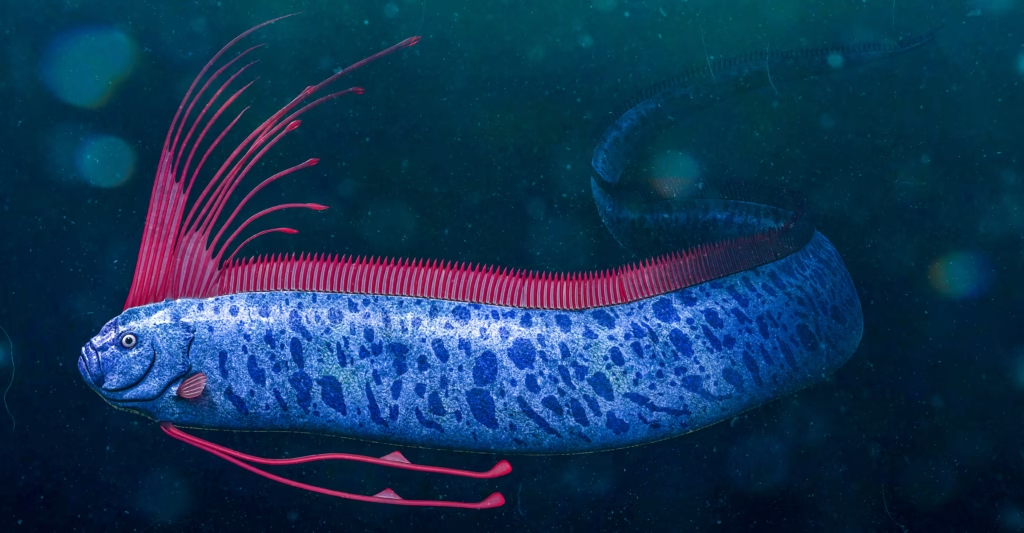The Mysterious Deep-Sea Creature Resurfaces
A rare deep-sea creature, often referred to as the “doomsday fish,” has been spotted once again, sparking widespread speculation and concern. The giant oarfish, a long, ribbon-like fish that usually resides in deep ocean waters, has been associated with seismic activity and natural disasters for centuries. But is there any truth behind these claims, or is it just a fascinating oceanic mystery?
1. What Is the Doomsday Fish?

The oarfish (Regalecus glesne), also called the “sea serpent,” is the longest bony fish in the world, reaching up to 36 feet in length. It typically dwells in deep waters, about 200 to 1,000 meters below the surface, making sightings extremely rare. The eerie appearance of the fish, along with its historical associations with earthquakes and tsunamis, has led to its ominous nickname—”doomsday fish.”
Unlike most deep-sea creatures, the oarfish lacks scales. Instead, its body is covered in a silvery, reflective skin with a red crest-like fin running along its entire back. It is a gentle, plankton-feeding fish that poses no direct threat to humans.
2. A Historical Perspective: Legends and Folklore
The connection between the oarfish and natural disasters dates back centuries. In Japanese mythology, the fish is known as “Ryugu no tsukai”, or “messenger from the sea god’s palace.” Historical records show that multiple oarfish sightings preceded the devastating 2011 Tōhoku earthquake and tsunami in Japan, fueling the belief that these fish serve as harbingers of seismic activity.
Ancient mariners often mistook oarfish for mythical sea serpents due to their elongated bodies and undulating swimming patterns. Even today, some coastal communities view the fish with a mix of awe and fear.
3. Why Is It Considered an Omen?
Legends from Japan and other coastal regions suggest that oarfish sightings precede major natural disasters. This belief stems from the idea that deep-sea creatures, like the oarfish, are more sensitive to underwater seismic shifts. Historically, multiple cases of oarfish appearing near shorelines have been followed by earthquakes, reinforcing the superstition.
Some scientists speculate that deep-sea fish could be reacting to changes in ocean pressure, gas emissions from seismic activity, or electromagnetic waves preceding an earthquake. However, there is no conclusive evidence proving this theory.
4. Recent Sightings and Public Reaction
In recent weeks, multiple oarfish sightings have been reported in various coastal regions. Fishermen and marine biologists have documented these appearances in Japan, the Philippines, and the U.S. west coast. These reports have fueled concerns online, with social media buzzing about the potential link between these deep-sea visitors and impending earthquakes or tsunamis.
Some viral videos show oarfish struggling near the surface, appearing disoriented or injured. Such sightings have reignited the debate about whether these fish truly sense environmental changes before disasters strike.
5. The Science Behind the Myth
While folklore and anecdotal evidence suggest a connection between oarfish and natural disasters, scientific research has yet to prove a direct link. Some experts argue that these fish may rise to the surface due to changes in water temperature, ocean currents, or sickness rather than tectonic activity. However, given their deep-sea habitat, it remains a mystery why they sometimes appear in shallow waters.
A study conducted in Japan analyzed historical oarfish sightings and their correlation with seismic activity. The results showed no significant pattern linking the fish to earthquakes. Scientists continue to study the behavior of deep-sea species to understand their movements better.
6. What Experts Are Saying
According to marine biologists, oarfish sightings should not be taken as a definitive sign of an impending disaster. Seismologists explain that there is no solid scientific evidence linking oarfish behavior to earthquake prediction. However, the presence of these rare creatures still intrigues scientists, prompting further research into their habits and physiology.
Some researchers believe that other marine creatures, such as certain species of sharks and eels, might be more reliable indicators of underwater seismic shifts due to their heightened sensitivity to electromagnetic changes in the ocean.
7. The Role of Climate Change
Some researchers suggest that climate change and human activities may be impacting marine ecosystems, potentially driving deep-sea creatures like oarfish closer to shore. Rising ocean temperatures, pollution, and habitat destruction could be disturbing their natural environment, leading to increased surface appearances.
Overfishing and deep-sea mining may also play a role in forcing these creatures into unfamiliar waters, further confusing their natural behaviors.
8. The Biological Mysteries of the Oarfish
Despite its legendary status, the oarfish remains largely mysterious. Unlike many fish, it lacks a swim bladder, an organ used to control buoyancy. Instead, it moves in a unique, ribbon-like motion, using its long dorsal fin to propel itself gracefully through the water.
Because of its deep-sea habitat, researchers rarely get the chance to study a healthy oarfish in its natural environment. Most recorded specimens are found washed ashore or dying, making it difficult to gather data on their lifespan, reproduction, and migration patterns.
9. What Should You Do If You See One?
If you ever come across an oarfish washed up on the shore or swimming near the surface, it’s important to document the sighting and notify marine experts. Scientists rely on these rare encounters to gather data about this elusive species. While the sighting itself is unlikely to predict an earthquake, it remains a fascinating and valuable find for oceanographers.
Taking pictures, noting the location, and reporting the sighting to local marine research centers can help scientists track oarfish migration patterns and environmental changes.
10. The Bottom Line: Myth or Reality?
The legend of the doomsday fish continues to captivate people worldwide, blending scientific curiosity with deep-rooted folklore. While there is no definitive proof that oarfish predict natural disasters, their sudden appearances always raise questions about the mysteries of the deep sea. Whether a sign of geological activity or just a rare natural event, one thing is certain—the sight of this giant, ghostly fish is always an extraordinary moment.
So, should we worry about an impending disaster? Probably not. But the ocean still holds countless secrets, and every oarfish sighting reminds us of the vast, unexplored world beneath the waves. Perhaps, instead of fear, we should see these encounters as an opportunity to learn more about the deep sea and its hidden wonders.
















